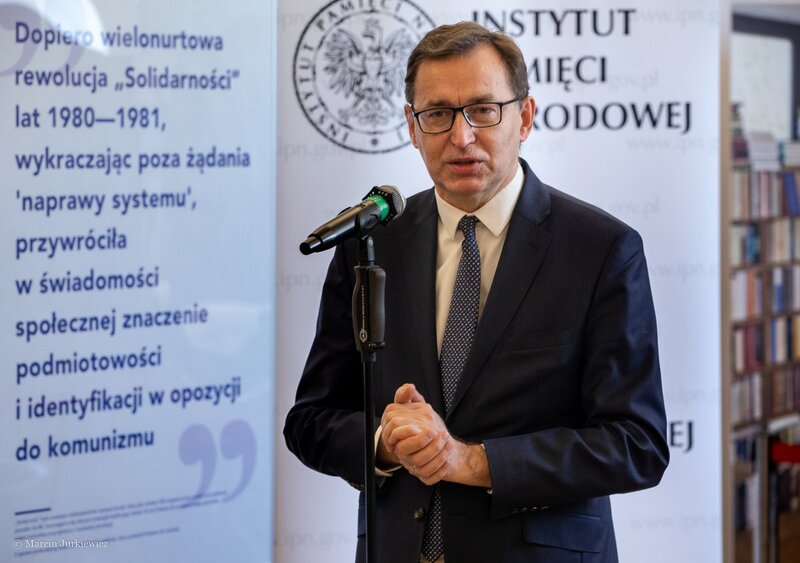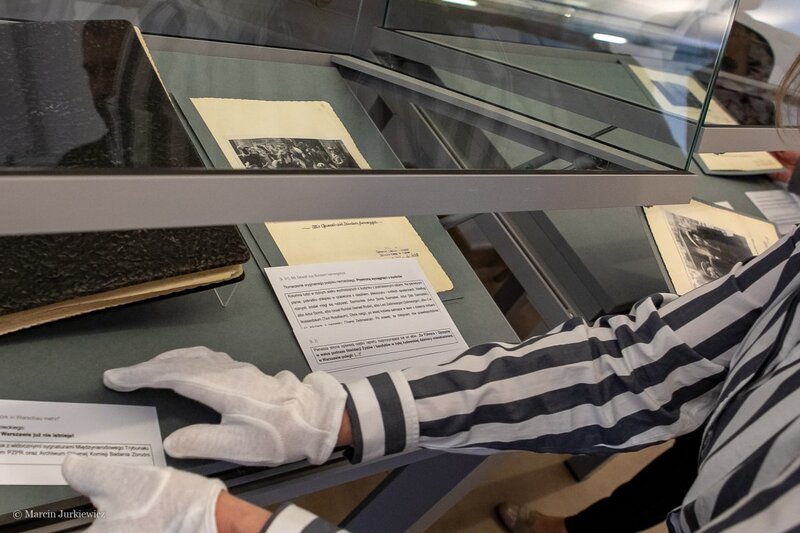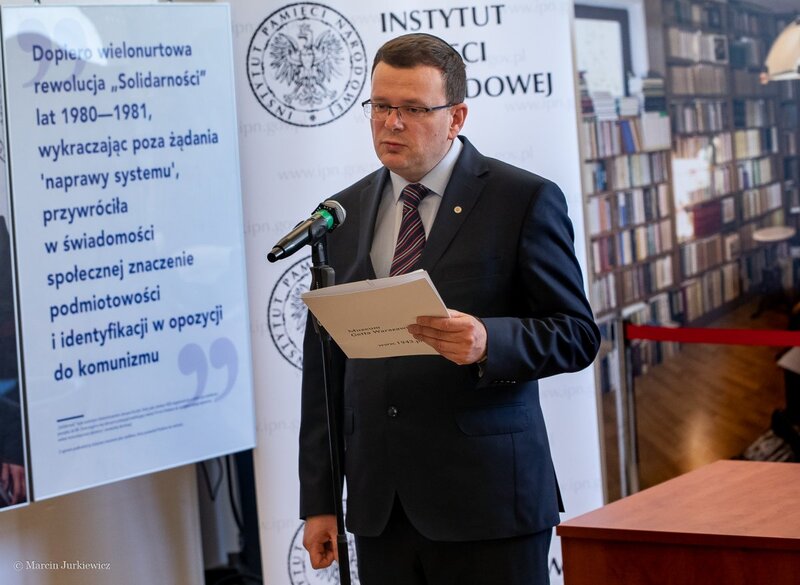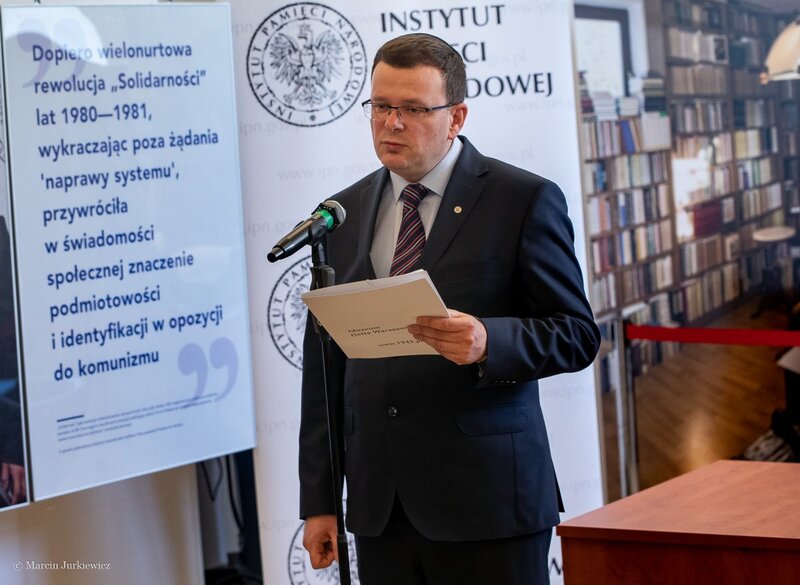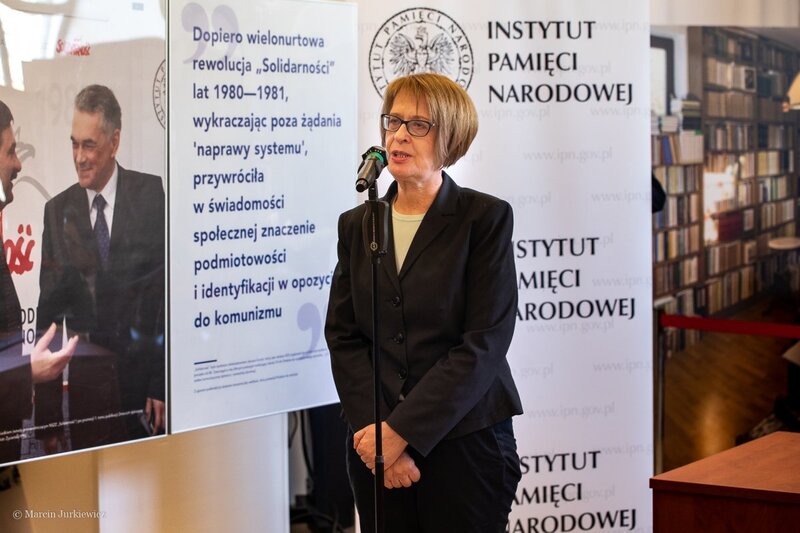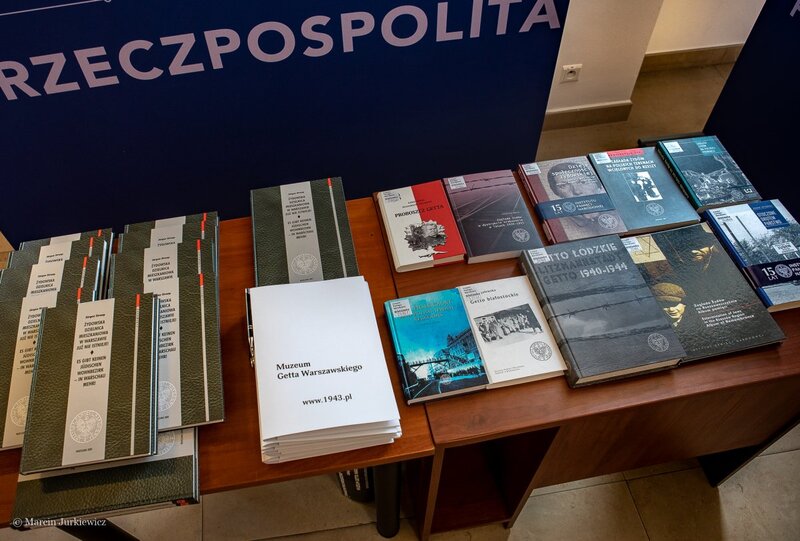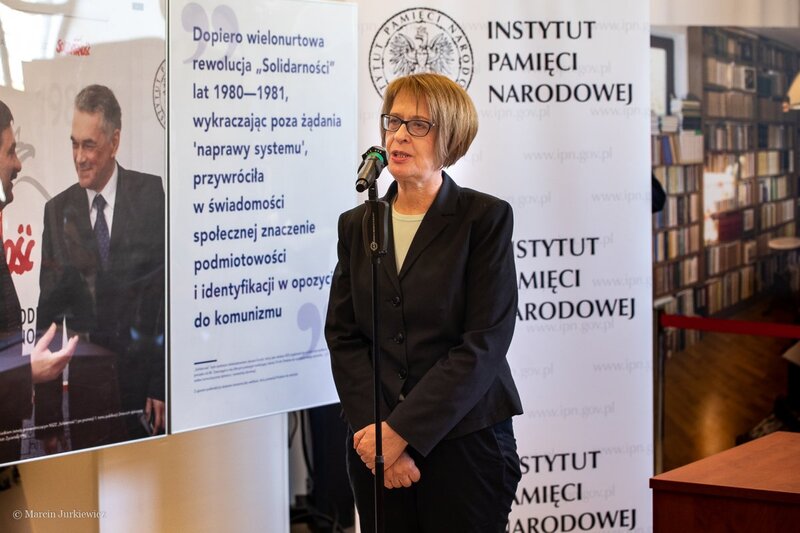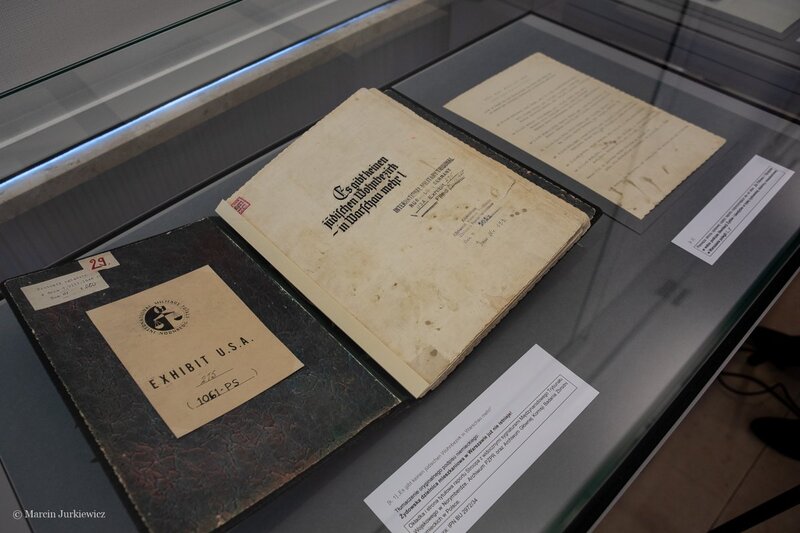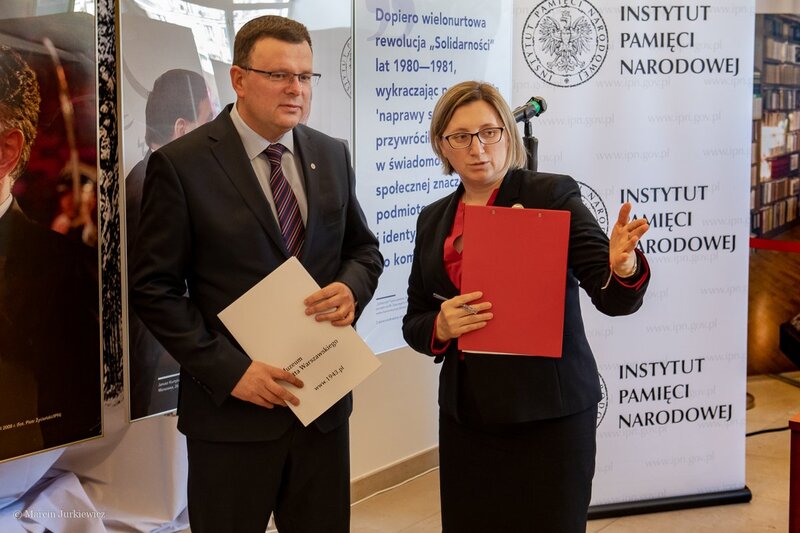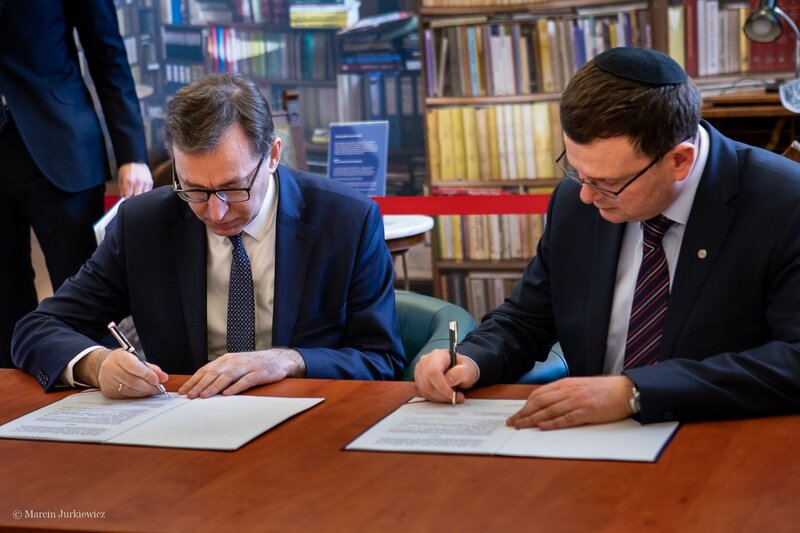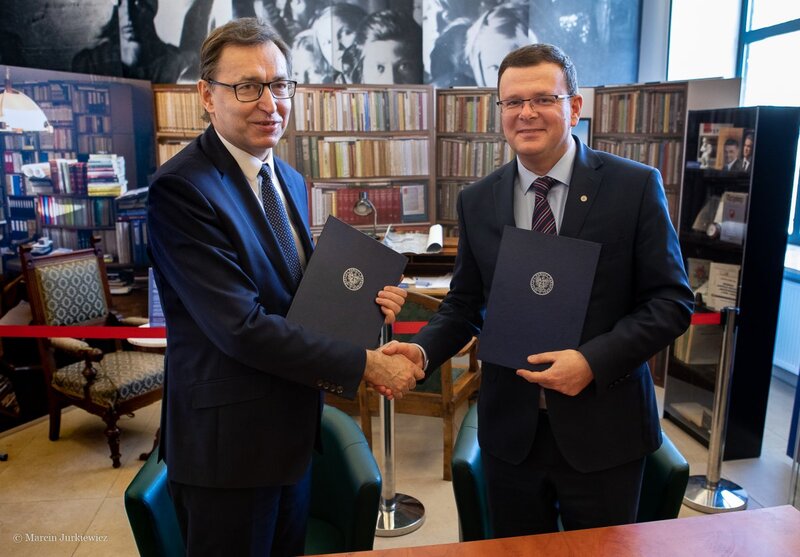After the presentation of the film from the IPN Archives, the President of the Institute of National Remembrance, Dr Jarosław Szarek and the Director of the Warsaw Ghetto Museum, Albert Stankowski, signed a cooperation agreement between the two institutions.
The Institute of National Remembrance warmly welcomed the initiative of creating the Warsaw Ghetto Museum, said the President of the IPN, Dr Jarosław Szarek. “During the Second World War Warsaw, as a victim of German totalitarianism, was a city of resistance and struggle. The spring of 1943 was one of its symbols” he said.
By virtue of the signed agreement, the institutions will cooperate in the field of education, information, exhibitions and research.
Emphasizing the importance of cooperation between the two institutions and the value of documents from the IPN resources regarding the Warsaw ghetto, the President of the Institute of National Remembrance said that the 20th century has left a tragic heritage of hatred, misery and suffering. We have an obligation to pass on this knowledge to current generations and future ones. The victory of those who took on an unequal fight for a dignified death- is our memory.
- Cooperation which will help in fulfilling the mission of the Institute: commemorating history, education, and joint scientific research is of great significance to us. The Warsaw Ghetto Museum is a new institution, but we are not writing history from scratch. That is why cooperation with various institutions is so vital for us - emphasized the Director of the Warsaw Ghetto Museum Albert Stankowski. - 76 years ago, those who survived the Great Liquidation Action were preparing for an unprecedented uprising, knowing that they are fighting for a dignified death. (...) And our task is to pass on the knowledge about those terrible times in order for them to never happen again - he added.
During the conference, the originals of archival materials from the IPN Archive were presented. The documents are related to the Warsaw Ghetto and the Uprising in the Ghetto which broke out on 19 April 1943.
- The IPN Archive is in possession of almost 4 km of documents which refer to the period of World War II. These are documents produced by the security services of the Third German Reich and 30 linear meters of the so-called eastern documents - said the Director of the IPN Archive Marzena Kruk. - Today we have prepared a sample of what can be found in the IPN Archive. Among the materials you can find a unique document – the Stroop Report, which in 2017 was added to UNESCO’s Memory of the World Register - she added.
- The Institute of National Remembrance is the Polish institution which has published the largest number of materials concerning the extermination of Jews. There is a wide range of possible future joint publication projects. I am very pleased that we will be able to cooperate in this field. The Warsaw Ghetto Museum could not have been created without the Institute of National Remembrance and this is why we feel honored to be able to sign the cooperation agreement between our institutions emphasized Hanna Węgrzynek, Deputy Director of the Warsaw Ghetto Museum.
The event was organized as part of the upcoming commemoration of the 76th anniversary of the Warsaw Ghetto Uprising. The main celebrations will start on 19 April at 12:00 in front of the Monument to the Ghetto Heroes, from where a March in Memory of the Insurgents will start.
The materials presented during the conference included:
1.Film footage from the streets of occupied Warsaw
Part of the presented material contains unique images of the Warsaw ghetto filmed from the outside - Chłodna Street, groups of Jews marching down the street, traffic observed from behind the barbed wire, a boy and men entering the ghetto being searched, people entering the ghetto, a group of children with guardians entering the ghetto. The video below is a fragment of an 8 mm film with images of the streets of occupied Warsaw and the Warsaw Ghetto presumably made by an anonymous soldier of the Wermacht in 1940-1941. In 1966, this film was handed over to the Main Commission for the Investigation of Nazi Crimes probably by the editor of Polish Television Jerzy Ambroziewicz who died on 11 April 1995, and blocked its dissemination. Since then, this material has not been widely published in its entirety, which is why the Archive of the Institute of National Remembrance has made efforts related to its digital reconstruction.
2. Report by Jürgen Stroop.
Jürgen Stroop's report is a unique document illustrating the crime of the Holocaust - the extermination of the Jewish population during World War II. The report is an official document giving an account of how the Germans suppressed the Uprising in the Ghetto in Warsaw - the largest separated residential district for Jews in occupied Europe - and its liquidation in the spring of 1943.
The optics of presenting the events described in the report are shocking. The Holocaust is depicted from the perspective of a criminal, not a victim, so that the document - contrary to the author's intentions - does not glorify the German "courage, strength and sacrifice" and becomes an indictment and evidence of the crimes committed against the Jewish population; instead of praising the merits of soldiers ruthlessly executing orders, it is a tribute to their innocent victims
The photographs found in the report contain extremely suggestive photos that have become permanently inscribed in the consciousness of people all over the world and are clearly associated with the Holocaust. Some of the photographs have become photographic symbols the Holocaust.
In 2017, the document was added to the UNESCO Memory of the World Register.
3. Supreme National Tribunal files in a criminal case against L. Fischer and others, containing original railway documents with data on "resettlers" directed to Treblinka, which were secured by Home Army soldier Franciszek Ząbecki.
4. Files of the secret German state police in Ciechanów / Płock in the case of Lotta Eckstein and Rosa Hutnik, escapees from the Warsaw Ghetto and documents concerning : Rosa Hutnik (died in KL Ravensbruck), L. Eckstein (died in the transition camp in Działdowo).
* * *
The uprising in the Warsaw Ghetto (19 April - 16 May 1943) was an expression of the determination of the Jewish population, which despite the lack of any hope for the success of the rebellion, stood up against its oppressors, fighting for their pride and a sense of dignity.
The Warsaw Ghetto, like all ghettos in the occupied Polish territories, was created and then destroyed as a result of the anti-Jewish, genocidal policy of the German authorities. The document about the creation of the ghetto (in German terminology: jüdische Wohnbezirk)) was signed in October 1940 by the governor of the Warsaw District, a member of the NSDAP and the Reichstag, Ludwig Fischer. The final report on the liquidation of the ghetto entitled Es gibt keine Jüdische Wohnbezirk in Warschau mehr (The Jewish Quarter of Warsaw is No More!) was prepared by SS-Gruppenführer Jürgen Stroop in May 1943.
Both these criminals were captured after the war and tried by the Polish judicial system.
In April and May 1943 several hundred poorly armed fighters of the Warsaw Ghetto fought against heavy artillery and aircraft of the overwhelming German forces, which included: 440 soldiers of the 3rd SS training and replacement armoured grenadier battalion, 381 soldiers of the SS training and replacement cavalry unit, 234 officers of the German Ordnungspolizei, 32 German officers of the Security Police (Sicherheitspolizei), 98 Wehrmacht soldiers and 335 SS-Trawnikimänner members. The Polonische Polizei, created by the Germans, did not enter the ghetto. The Polish fire brigade was only called by the Germans to put out specific fires.
Polish society, as well as the vast majority of Polish conspiracy groups, sympathized with Jewish insurgents and condemned the German murders. The Polish underground, which had no chance of winning the fight against the Germans, organized at least some attacks on German troops stationed under the walls of the ghetto. At least two soldiers of the Polish Home Army, Eugeniusz Morawka "Młodek" and Józef Wilk "Orlik", were killed in them. From December 1942, the "Żegota" Council for Aid to Jews operated in German occupied country. The Polish underground and the Polish government-in-exile in London informed the world about German crimes in occupied Poland. The Polish Prime Minister, Władysław Sikorski, condemned the German crimes in the Warsaw ghetto and announced the prosecution of the perpetrators. Secret emissaries of the Polish governmentwho personally visited Warsaw ghettos, such as Jan Karski, spread the message of the Jewish underground throughout the world, and called the Allies for actions aimed at stopping German crimes.

